

Robert Smalls was raised as a slave in Charleston, South Carolina, where he learned about steamboats – including how to pilot large vessels along the Atlantic seaboard. He earned a reputation for exceptional navigational skills, and at the outbreak of the Civil War was forced into service for the Confederacy as quartermaster on the Planter, a 300-ton side-wheel steamer. As quartermaster, Smalls was in charge of the ship’s steering, thus making him the de facto pilot of the Planter; but he did not hold that title, for such an important post was not allowed a black slave in the Confederate south.

Always watchful for an opportunity to gain his freedom, and recognizing the potential in this situation, Smalls alerted the families of the crew to be in hiding nearby. Knowing he would have to pilot the ship past Confederate sentinels, he donned the captain’s clothing and hoisted the Confederate flag. With his wife, children, and other African-American slave families onboard, Smalls sailed the ship past Confederate sentries in Charleston Harbor and out to the Union blockade at sea.
Moving the ship along slowly, and blowing the usual signals, Smalls was successful in not attracting unwanted attention. In fact, a Confederate soldier later reported that even though he saw the Planter moving away from the wharf, he didn’t “think it necessary to stop her, presuming that she was but pursuing her usual business.”
Smalls and his crew still faced two major obstacles. The first was Fort Johnson (which Smalls safely passed, giving the customary steam-whistle salute); the second was Fort Sumter, the starting place of the Civil War. As the Planter approached its stark gray walls, some of Smalls’ crew urged him to turn back, fearing that the Sumter guards would board and inspect the ship.
Smalls cried out to God: “Oh, Lord, we entrust ourselves into Thy hands. Like Thou didst for the Israelites in Egypt, please stand guard over us and guide us to our promised land of freedom.” Rather than retreating, he continued bravely on, knowing that if they were stopped or shot, at least they would enter heaven as free men.
As they approached Fort Sumter, Smalls – still wearing the familiar hat and coat of the captain – turned his back slightly to the sentry in order to obscure his own face and features. He then signaled with the whistle, asking for permission to pass. The crew waited in tense expectation; and after what seemed like hours, the Confederate guard finally answered, “Pass the Planter!”
Even though the most difficult part of the escape was now behind them, it was still too early to celebrate. When the Planter eventually reached the outer edge of Confederate waters, Smalls replaced the Rebel flag with a white sheet of surrender – but nearly too late. The commander of an oncoming Union vessel, the US Onward, was ready to give the command to fire on the Planter before recognizing the flag of truce. He guided his ship alongside the Planter and the Union crew boarded the vessel. When they asked for the captain, Smalls proudly answered, “I have the honor, sir, to present the Planter, formerly the flagship of General Ripley!”
The ship was now in Union hands; but even more valuable to the Union was Smalls’ extensive knowledge of Confederate placements around Charleston. Upon delivering these precious spoils, Smalls explained with a wry smile, “I thought they might be of some service to Uncle Abe.”
President Lincoln personally invited Robert Smalls to Washington, where he and his crew were recognized for their bravery. Smalls was then commissioned as Second Lieutenant in the 33rd Regiment of United States Colored Troops. (For a black American to be commissioned as an officer was extremely rare and was an exceptional honor.) After receiving his commission, Smalls was made the official pilot of the Planter, now sailing for the Union.
The Planter was assigned to transport service, delivering supplies along the coastal waterway near Charleston. On a routine trip in November 1863, the Planter came under Confederate bombardment. The shelling proved so intense that the Union captain of the ship panicked, wanting to surrender. Smalls refused, knowing that he and the crew would be killed if captured by the Rebels. (The Confederacy had issued orders that black Americans who surrendered were not to be made prisoners but were to be put to death on the spot.) The frightened Captain fled below deck, leaving Smalls in charge; he brought the ship safely through the shelling, landing amidst the cheers of thousands gathered at the dock awaiting the supplies. Union Major General Quincy Gillmore immediately promoted Smalls to Captain, a position he held until the end of the war. Smalls eventually rose to the rank of Major General in the South Carolina Militia.
Smalls served as captain until the army sold Planter in 1866 after the end of the war.
After the War, Smalls was elected as a Republican to the South Carolina House and then to the United States Congress, where he served for nine years. As a Member of Congress, he pursued equal treatment for black Americans.
Smalls died of malaria and diabetes in 1915 at the age of 75. He was buried in his family’s plot in the churchyard of the Tabernacle Baptist Church in downtown Beaufort. The monument to Smalls in this churchyard is inscribed with a statement he made to the South Carolina legislature in 1895: “My race needs no special defense, for the past history of them in this country proves them to be the equal of any people anywhere. All they need is an equal chance in the battle of life.”
On March 25, 1876, while trying to tow a grounded schooner, Planter sprang a plank in the bow and began to take on water in the hold. Its captain elected to beach the steamer and repair the plank, hoping to get off the beach with the next high tide. However, stormy seas battered the Planter as the tide rose and the ship was too badly damaged and had to be abandoned. Upon hearing of its loss, Robert Smalls was reported to have said that he felt as if he had lost a member of his family.
Expeditions to find the Planter began in 2010. In May 2014 the NOAA (National Oceanic and Atmospheric Administration) reported that it believed it had found Planter’s wreck.
Sources: Wallbuilders.com, Wikipedia.com, biography.com
No Comments
Leave a comment Cancel